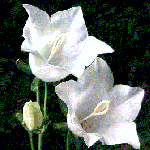 |
CAMPANULACEAE - The Bellflower Family
This plant family contains mostly perennial plants, although some are annual or biennial, but hardly any shrubs. Plants of this family are found in most parts of the world except Africa, although the majority are found in the temperate regions. The flowers are most usually blue. The family includes Campanulas, Symphyandra, Edraianthus, and almost all are grown for ornament. They may be several feet tall, or only a few inches. |
Characteristics of this Plant Family:
Leaves, Stem & Roots ~ There is a variety of leaf shapes in this family, although they are undivided. They may be kidney-shaped, oval, round, or like a nettle. The stem varies with the size and type of the plant - it may be woody, wiry or brittle. The root is often a tuber or at least fleshy.
Flowers ~ It is the flowers which give this plant family its name. Campanula is Latin for bell, and the majority of the flowers are bell-shaped to some degree. They may be long tubular bells, or open starry shapes. In some members of the family, the likeness to a bell is not apparent - in Jasione or Phyteuma, for instance, where there are many flowers together forming a single 'flower-head'. The flower parts are in fives - this is most noticeable in the five points at the end of the bell, and the five points to the sepals (calyx). Flowers occur in all shades of blue, and in mauves, purples, white, and rarely pink or cream.
Seeds ~ Each single flower can produce thousands of seeds. They form in three chambers in the seed capsule, and are usually tiny.
(Click here for more information and examples of seedpods in this Family.)
Members of this Family usually have:
Blue (or white) bell-shaped flowers
Lots of small seeds